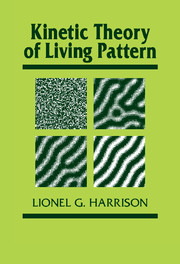Book contents
- Frontmatter
- Contents
- Preface
- Part I Macroscopics without mathematics
- 1 Introduction
- 2 Morphogen: one word for at least two concepts
- 3 Pictorial reasoning in kinetic theory of pattern and form
- 4 Structure, equilibrium, kinetics
- Part II Pattern-forming processes
- Part III Bringing experiment and theory together
- References
- Index
2 - Morphogen: one word for at least two concepts
Published online by Cambridge University Press: 22 September 2009
- Frontmatter
- Contents
- Preface
- Part I Macroscopics without mathematics
- 1 Introduction
- 2 Morphogen: one word for at least two concepts
- 3 Pictorial reasoning in kinetic theory of pattern and form
- 4 Structure, equilibrium, kinetics
- Part II Pattern-forming processes
- Part III Bringing experiment and theory together
- References
- Index
Summary
William of Ockham's name is known to most scientists only for the principle of economy in theoretical explanations – Ockham's razor – most succinctly stated as follows: A plurality must not be asserted without necessity. It is less well known that three centuries before Newton, Ockham asserted that there was no objection to the concept of action at a distance (Crombie, 1959).
Kinetic theory of living pattern and form is essentially concerned with both of these preoccupations of Ockham. It stems from a recognition that a kind of action at a distance must be operating whenever, in biological development, a shape appears in the absence of any antecedent of the same shape or of a precise geometrical fitting together of parts. The action must be some form of communication over the entire scale of the new pattern at, or slightly before, the time of its first morphological appearance. The scale of the morphogenetic field may be the size of a single cell, or even part of a large cell, or the span of many cells in a tissue. In very diverse examples, pattern often becomes visible at a size of tens of micrometres. Kinetic theory can readily accommodate at least the range from 1 μm to 1 mm.
Of the various possible kinds of communication, molecular diffusion is given the most prominence in this book because reaction-diffusion theory is the most extensively developed branch of kinetic theory.
- Type
- Chapter
- Information
- Kinetic Theory of Living Pattern , pp. 31 - 55Publisher: Cambridge University PressPrint publication year: 1993



